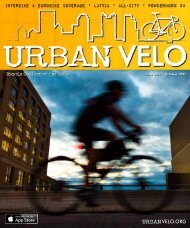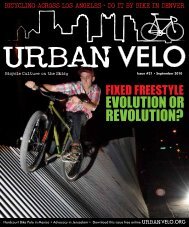You also want an ePaper? Increase the reach of your titles
YUMPU automatically turns print PDFs into web optimized ePapers that Google loves.
What was your job at Bridgestone?<br />
I was hired as an in-house technical rep to talk to<br />
dealers and bike riders, since nobody else “in house”<br />
knew about bikes or could talk the language. I did tons<br />
of data entry. Later I became Marketing Manager, I<br />
wrote ads and catalogues. At about the same time I had<br />
a lot of influence over the designs of the bikes and the<br />
parts. But the official designers were smart engineering<br />
types, who would take my suggestions, most, not<br />
all, and turn them into bikes. My “design” roles have<br />
always been overstated.<br />
Where did you learn to design bicycles?<br />
I took a mechanical drawing class in high school,<br />
and my dad was a mechanical engineer. I used to draw<br />
frames on his drawing table. I firmly believe a penciland-paper<br />
approach helps relationships and proportions<br />
sink in more effectively. But, let me say this without<br />
sounding overly humble: Designing frames is not<br />
that hard. I could teach anybody everything I know in<br />
five hours.<br />
74 URBANVELO.ORG<br />
Your writing sets you apart from other frame designers.<br />
Have you always liked to write?<br />
I don’t know about “always,” but when I was fourteen<br />
I wrote an article about a new way to tie trout<br />
flies, and submitted it to Field and Stream, Outdoor<br />
Life, and Sports Afield. They all rejected it. But at least<br />
I wrote it, and it was pretty good for me at the time.<br />
I learned more about writing from reading, including<br />
reading books about writing. I don’t have sharp skills<br />
but I know how to avoid common mistakes.<br />
You have the reputation as an industry iconoclast,<br />
yet you are influential in the industry and people<br />
tend to agree with most of what you say.<br />
I think it’s natural to focus on the stuff you find<br />
outrageous. But I don’t say things that I believe to be<br />
outrageous. I have opinions, just as anybody who has<br />
a background in any field does. I have experience. If<br />
opinions didn’t follow, there’d have to be something<br />
missing in my brain. But, I don’t preface every opinion<br />
with “in my opinion,” because that’s a waste of time.<br />
Just because you like or agree with something I say<br />
doesn’t mean you have to join my cult and agree with<br />
everything, and I’ve changed over the years.<br />
Does strange clothing, like tweed, marginalize<br />
cycling?<br />
I tend to think that bike extremism, in the hardware<br />
or clothing, is like a snake that grows from both<br />
ends. One end (usually the high tech/innovative end)<br />
starts something, and then the other end reacts to<br />
it, with the unstated or even unintended goal being a<br />
kind of balance in the whole snake. For instance, onespeeds<br />
were nowhere until 9-speeds got popular, and<br />
now that Joe Schmoe dresses like a European Pro,<br />
we have tweed rides as the balance. Balancing kind of<br />
requires an opposite extreme, the Tweeders are providing<br />
a service. The Tweedies make it easier for bike<br />
riders to fall into the sane middle range.<br />
I don’t see any point in costuming up for a bike ride.<br />
If you saw a ten-year old kid [in spandex], you’d think,<br />
“how sad.” When I see 65-year olds do it, I think the<br />
same. But to each his/her own. My everyday “uniform”<br />
is totally bike ready, and I don’t mean only for a twomile<br />
jaunt.

















